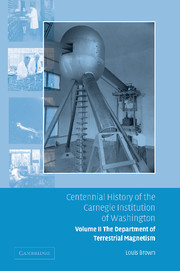Book contents
- Frontmatter
- Contents
- Foreword by Richard A. Meserve
- Preface
- 1 Establishment
- 2 Cruises and war
- 3 Expeditions
- 4 Measurements: magnetic and electric
- 5 The Fleming transition
- 6 The last cruise
- 7 The magnetic observatories and final land observations
- 8 The ionosphere
- 9 Collaboration and evaluation
- 10 The Tesla coil
- 11 The Van de Graaff accelerator
- 12 The nuclear force
- 13 Fission
- 14 Cosmic rays
- 15 The proximity fuze and the war effort
- 16 The Tuve transition
- 17 Postwar nuclear physics
- 18 The cyclotron
- 19 Biophysics
- 20 Explosion seismology
- 21 Isotope geology
- 22 Radio astronomy
- 23 Image tubes
- 24 Computers
- 25 Earthquake seismology
- 26 Strainmeters
- 27 The Bolton and Wetherill years
- 28 Astronomy
- 29 The solar system
- 30 Geochemistry
- 31 Island-arc volcanoes
- 32 Seismology revisited
- 33 Geochemistry and cosmochemistry
- 34 The Solomon transition
- 35 The support staff
- 36 Epilogue
- Notes
- Index
18 - The cyclotron
Published online by Cambridge University Press: 06 January 2010
- Frontmatter
- Contents
- Foreword by Richard A. Meserve
- Preface
- 1 Establishment
- 2 Cruises and war
- 3 Expeditions
- 4 Measurements: magnetic and electric
- 5 The Fleming transition
- 6 The last cruise
- 7 The magnetic observatories and final land observations
- 8 The ionosphere
- 9 Collaboration and evaluation
- 10 The Tesla coil
- 11 The Van de Graaff accelerator
- 12 The nuclear force
- 13 Fission
- 14 Cosmic rays
- 15 The proximity fuze and the war effort
- 16 The Tuve transition
- 17 Postwar nuclear physics
- 18 The cyclotron
- 19 Biophysics
- 20 Explosion seismology
- 21 Isotope geology
- 22 Radio astronomy
- 23 Image tubes
- 24 Computers
- 25 Earthquake seismology
- 26 Strainmeters
- 27 The Bolton and Wetherill years
- 28 Astronomy
- 29 The solar system
- 30 Geochemistry
- 31 Island-arc volcanoes
- 32 Seismology revisited
- 33 Geochemistry and cosmochemistry
- 34 The Solomon transition
- 35 The support staff
- 36 Epilogue
- Notes
- Index
Summary
The cyclotron represents a curious path in the history of the Department. During the 1930s particle accelerator development generally followed two paths: machines in which high voltage is applied to a vacuum tube within which electrodes form an electric field, and machines in which the particles spiral outward in a quasi-homogeneous magnetic field, acquiring an increment of acceleration from a synchronously time-varying high voltage. The Van de Graaff machine belongs, indeed dominates, to this day, the former, and the cyclotron, which has given rise to a large number of devices that now provide the ultimate in high energies, dominated the latter. During those early years Tuve was the undisputed master of electrostatic machines while his childhood friend, Ernest Lawrence, held the same position for the resonance machines.
In their early forms, Van de Graaffs with their well-focused mono-energetic beams became the instruments for nuclear spectroscopy, whereas cyclotrons became the factories of radioisotopes. Lawrence and Tuve both pushed the development of a larger machine as soon as one model had proved satisfactory. By 1939 Lawrence had built the largest accelerator in the world, called the 60 inch from the diameter of the magnetic field that controlled the motion of ions created at the center. The energy of the ions was determined by the field of the electromagnet, which was of the order of 15 000 gauss. The accelerating voltage was applied through a 20 MHz generator in step with the motion of the ions.
- Type
- Chapter
- Information
- Centennial History of the Carnegie Institution of Washington , pp. 133 - 138Publisher: Cambridge University PressPrint publication year: 2005



